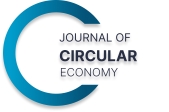Mourning the Butterfly, Welcoming the Monster: Embracing Divergent Circularities?
Editors: Andrea Bortolotti1, Giulia Caterina Verga2, Dario Minervini3
1 Department of Architecture and Urban Studies, Politecnico di Milano (Italy)
2 Building, Architecture and Town Planning Department, Université Libre de Bruxelles (Belgium)
3 Department of Social Sciences, Università Federico II di Napoli (Italy)
Keywords: circularity; circular economy, resource governance, assemblage thinking, urban policy and planning; epistemic communities
More than a decade ago, Stewart Lockie (2012:11) described sustainability as "more than a signifier of desirable social-ecological states" but rather as an "assemblage of ideas, techniques, institutions" through which we perceive, conceive, and act in the world—a "monster", like "Frankenstein’s creation, never entirely brought under control" (2012: 3). Now that the circular economy has become a new trope for sustainability, we argue for resisting the illusion of perfection embedded in closed production–consumption loops and instead acknowledging the inherent messiness of real-world attempts to implement circularity (Nylén, Johanson, and Vakkuri 2023; Verga and Khan 2022). We propose embracing epistemological hybridity and diversity (Bortolotti and Minervini 2024) as a theoretical lens for examining circularity in a situated and divergent manner—as an assemblage of human and non-human actors that are put in place and stabilised to translate the supposed circular model into practice. Such hybridity foregrounds the dynamic interplay of interests, values, and logics, which often results in compromises, reinterpretations, and contested implementations of what is envisioned in circular economy policies and programmes.
In this special issue, we invite contributions from scholars in geography, urban planning, sociology, transition studies, the environmental humanities, and political ecology to question the dominance of the "butterfly model" of the circular economy and its application in practice. What new understanding of circularity emerges when we abandon the reductionist, recursive, and confirmatory metaphor of the “butterfly” in favour of a logic that is situated, transformative, and generative of alternative models? What practical examples can be found in real-world contexts that illuminate a still under-explored, alternative, or more radical understanding of circularity? We advocate for a Frankensteinian approach to CE—one that embraces assemblage, multiplicity, and contradiction. The monster as a metaphor invites us to welcome the hybrid, the messy, and the unclassifiable. It challenges the desire for a singular, polished model and instead calls for a pluralist, adaptive, and at times potentially disturbing vision of circularity. Ultimately, this special issue seeks to explore how alternative and radical interpretations of circularity emerge from everyday and experimental practices of transforming urban resources—and how such perspectives can inform more context-sensitive urban policies and planning.
Contributions are welcome, presenting empirical and grounded research that investigates topics such as, but not limited to:
• Examples of communication and programmatic initiatives that move beyond the reductionist interpretation of the “butterfly model”, engaging instead with the complexity, instability, and creativity inherent in both institutional and community-driven forms of environmental governance.
• Circularity examples that are not yet recognised and classified as such, as they diverge from the mainstream modelling of the circular economy, yet embody pluralistic and context-specific pathways. These include the materialization of adaptable designs and ideas supporting local regenerative practices (maintenance, repair, care-driven practices, etc.).
• Alternative time frames of circularity: exploring the temporalities of circularity offers a lens to reconsider how materials and immaterial configurations—such as infrastructures, social relations, and spatial arrangements—interact and evolve. By questioning the pace, duration, rhythm, and delay involved in urban transformations, these temporal perspectives enrich our understanding of how circular processes unfold, stagnate, or evolve.
• Examples of alternative circularity discourses emerging from contexts marked by exclusion and uneven geographies—particularly those shaped by race, gender, class, ability, and other intersecting forms of domination and oppression. In what ways do these situated, and often marginalised, narratives challenge or reconfigure the Western-centric and postcolonial paradigms that currently frame circular economy discourses and their implementation?
• The failure of the neo-liberal agenda of optimization of urban service provision through the market, and the emergence of alternative models of co-production and self-organisation in marginalised contexts and geographical areas. This may involve adaptive approaches to urban infrastructure that prioritize the judicious use of natural resources, maximise locational advantages, and promote locally grounded forms of environmental stewardship.
Submission Guidelines
Manuscripts should be prepared in accordance with the journal’s author guidelines. Submissions will undergo double-blind peer review. Both conceptual and empirical papers are welcome.
Format and word count
Review: 4,500–6,000 words
Research Papers: 3,500–6,000 words
Perspectives: 800–1,000 words
All word counts exclude tables, illustrations, and references.
Manuscripts should be submitted via the journal’s online system , selecting “Special Issue: Mourning the Butterfly, Welcoming the Monster: Embracing Divergent Circularities?”.
All submissions must adhere to the Journal of Circular Economy’s guidelines and terms including publication fees.
Submission Deadlines
Extended abstracts (500–750 words): 15 March 2026
Notifications of accepted abstracts: 15 April 2026
Full papers due: 15 September 2026
Expected publication: October 2027 (rolling publication upon acceptance)
Contact
Questions: [email protected]
References
- Bortolotti, Andrea, & Minervini, Dario. (2024). The Opening Circle: Four Moves to Rethink the Circular Economy. BDC. Bollettino Del Centro Calza Bini, 24(2), 113–129. https://doi.org/10.6093/2284-4732/11327
- Lockie, Stewart. (2012). Sustainability and a Sociology of Monsters. Sociologica, (2), 1–14. https://doi.org/10.2383/38273
- Nylén, Erkki-Jussi, Johanson, Jan-Erik, & Vakkuri, Jarmo. (2023). The Loop from Idealised to Messy − Untangling Ideational Features of the Circular Economy and Hybridity in Its Making. Environmental Science & Policy, 140, 146–151. https://doi.org/10.1016/j.envsci.2022.11.023
- Verga, Giulia Caterina, & Khan, Ahmed Zaib. (2022). Space Matters: Barriers and Enablers for Embedding Urban Circularity Practices in the Brussels Capital Region. Frontiers in Built Environment, 8. https://doi.org/10.3389/fbuil.2022.810049
Receive an update when the latest issues in this journal are updated
Subscribe